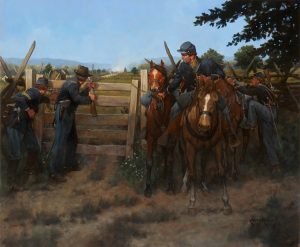50 signed and numbered prints
Late in the afternoon of July 2, 1863, Confederate General John B. Hood’s Division swept across the fields of Gettysburg, spearheading the attack on the exposed Union left flank. Hood directed his attack toward the rocky area known as the Devil’s Den, a formation of huge, ancient boulders jutting out of the landscape in front of the hills known as Big and Little Round Top.
Hood was seriously wounded at the beginning of the attack and command control of the assault was lost. “When the command was given to charge we moved forward as fast as we could . . . It was between a half and three-quarters of a mile across an open field, over a marshy branch, over a stone fence and up a very rugged and rocky hill. . .” wrote John West, of the 4th Texas. The ridge was defended by Union men of the III Corps Division of Brigadier General J. H. Hobart Ward (2nd Brigade, 1st Division) including the 124th New York, known as the Orange Blossom Regiment. Colonel Ellis and Major James Cromwell of the 124th were mounted despite protests that they would be killed. Major Cromwell stated, “The men must see us today.”
As the Confederates attacked, the four guns of Capt. James E. Smith’s 4th New York Independent Battery fired in support of the defenders, dueling with Confederate artillery on Warfield Ridge. The 3rd Arkansas and 1st Texas Infantry reached the stone wall in the triangular field from which place they sniped at Smith’s gunners. The 3rd Arkansas was fought to a standstill by the 20th Indiana and the 86th New York who were supported by fire from the 124th New York. John Wilkerson of the 3rd Arkansas recalled that, “our ranks were getting thin. It was fight all the time. Each side wanted the protection of those rocks . . .” Soldiers of both sides fought savagely amongst the huge boulders, some falling between the rocks. The fighting was so severe that this part of the field has ever since been known as the Slaughter Pen.
As was occurring elsewhere on the field, the overwhelming tide of Confederates had its inevitable effect. The combined pressure of Law’s and Robertson’s brigades, backed by Benning’s brigade broke the Union line on Houck’s Ridge. The 124th New York and other units were driven back. Without infantry support, Smith lost all of his guns when Benning’s brigade charged headlong into the storm of shot and canister, ignoring casualties that ripped holes in their ranks. “The 15th and 20th (Georgia) clambered over the rocks and pressed forward . . . the enemy, dismayed at such daring, began to break . . .”
The Confederates overran the Devil’s Den and used it to stage attacks against Little Round Top. Using the natural cover of the boulders, long range sniping at the Federals on Little Round Top continued the rest of the day.
| Medium | |
|---|---|
| Size | 11" x 14", 20" x24" |
| Type |



